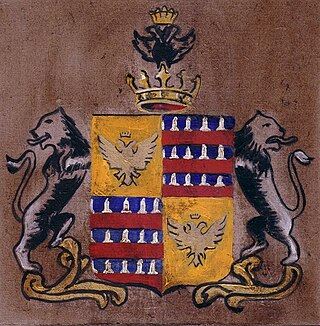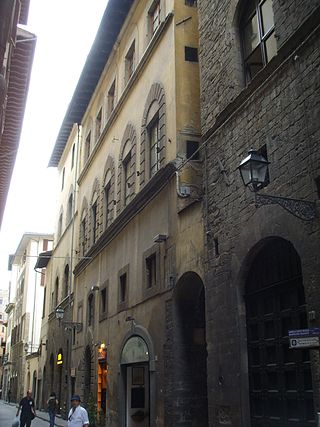
The Acciaioli family, also spelled Acciaiuoli, Accioly, Acciajuoli or Acioli was an important Italian noble family from Florence, whose members were the ruling Dukes of Athens.

The Acciaioli family, also spelled Acciaiuoli, Accioly, Acciajuoli or Acioli was an important Italian noble family from Florence, whose members were the ruling Dukes of Athens.
Family name is also written Acciaioli, Acciainoli, or Accioly, Accioli, Acioli and Acyoly in Portugal and Brazil, where there are branches of it. Descent can be traced in an unbroken line from one Gugliarello Acciaioli in the 12th century; family legend says that Gugliarello (a name possibly derived from It. guglia, needle) migrated from Brescia to Florence in 1160 because they were Guelphs and fled Barbarossa's invasion of Northern Italy.
The Acciaioli founded a powerful bank in the 13th century (Compagna di Ser Leone degli Acciaioli e de' suoi consorti) which had branches from Greece to Western Europe until the bank collapsed in 1345. [1]
Bishop Angiolo Acciaioli briefly ruled Florence in the mid-14th century after the deposition of Gauthier de Brienne. Later they associated themselves to the Albizzi and then to the elder Medici in the 15th century. From about 1390 to 1460 they ruled the Duchy of Athens and kept close ties with the younger branch of the Medici through the marriage of Laudomia Acciaioli to Pierfrancesco de' Medici, from which the later Grand Dukes of Tuscany are descended, as well as several royal houses. [2] In Florence, the Lungarno degli Acciaioli borders the Arno from the Ponte Vecchio to the Ponte Santa Trinita.
Simone di Zanobi Acciaioli migrated before 1512 to the island of Madeira where he represented the family's commercial interests. The Portuguese and Brazilian Accioly, Accioli or Acioli family is descended from him and were part of the Portuguese nobility.

The Duchy of Athens was one of the Crusader states set up in Greece after the conquest of the Byzantine Empire during the Fourth Crusade as part of the process known as Frankokratia, encompassing the regions of Attica and Boeotia, and surviving until its conquest by the Ottoman Empire in the 15th century.

The Archdiocese of Florence is a Latin Church metropolitan see of the Catholic Church in Italy. It was traditionally founded in the 1st century, according to the 14th century chronicler Giovanni Villani. The diocese was directly subordinate to the Holy See (Papacy) until 1420.
Angelo II Acciaioli was an Italian Catholic cardinal.
Zanobi Acciaioli was an Italian Dominican friar, a member of the Acciaioli family of Florence. He was Librarian of the Vatican under Leo X. He joined the Dominican convent on 8 December 1495. He learned Greek and Hebrew towards the latter part of his life, and was appointed in 1518 prefect of the Vatican Library.

Pierre Franqueville, generally called Pietro Francavilla, was a Franco-Flemish sculptor trained in Florence, who provided sculpture for Italian and French patrons in the elegant Late Mannerist tradition established by Giambologna.

The Duchy of Neopatras was a principality in southern Thessaly, established in 1319. Officially part of the Kingdom of Sicily, itself part of the Crown of Aragon, the duchy was governed in conjunction with the neighbouring Duchy of Athens, it enjoyed a large degree of self-government. From the mid-14th century, the duchies entered a period of decline: most of the Thessalian possessions were lost to the Serbian Empire, internal dissensions arose, along with the menace of Turkish piracy in the Aegean and the onset of Ottoman expansion in the Balkans. Enfeebled, the Catalan possessions were taken over by the Florentine adventurer Nerio I Acciaioli in 1385–1390. The title of Duke of Neopatras was held by the heir of the King of Sicily.

Nerio I Acciaioli or Acciajuoli was the de facto Duke of Athens from 1385 to 1388, after which he reigned uncontested until his death in 1394. Born to a family of Florentine bankers, he became the principal agent of his influential kinsman, Niccolò Acciaioli, in Frankish Greece in 1360. He purchased large domains in the Principality of Achaea and administered them independently of the absent princes. He hired mercenaries and conquered Megara, a strategically important fortress in the Duchy of Athens, in 1374 or 1375. His troops again invaded the duchy in 1385. The Catalans who remained loyal to King Peter IV of Aragon could only keep the Acropolis of Athens, but they were also forced into surrender in 1388.

Nerio II Acciaioli (1416–1451) was the Duke of Athens on two separate occasions from 1435 to 1439 and again from 1441 to 1451.
Chiara Zorzi or Giorgio, also Clara or Claire, was duchess consort of Athens by marriage to Nerio II Acciaioli, Duke of Athens, and regent of Athens during the minority of her son Francesco I from 1451 until 1454.

Lucrezia de' Medici was a member of the House of Medici and by marriage Duchess consort of Ferrara, Modena and Reggio from 1558 to 1561.
The decade of the 1460s in art involved some significant events.

Angelo Acciaioli was an Italian Roman Catholic bishop from Florence.

The Giunti were a Florentine family of printers. The first Giunti press was established in Venice by Lucantonio Giunti, who began printing under his own name in 1489. The press of his brother Filippo Giunti (1450–1517) in Florence, active from 1497, was a leading printing firm in that city from the turn of the sixteenth century. Some thirty members of the family became printers or booksellers. A press was established in Lyon in 1520. By about 1550 there were Giunti bookshops or warehouses in Antwerp, Burgos, Frankfurt, Lisbon, Medina del Campo, Paris, Salamanca and Zaragoza, and agencies in numerous cities of the Italian peninsula, including Bologna, Brescia, Genoa, Livorno, Lucca, Naples, Piacenza, Pisa, Siena and Turin, as well as the islands of Sardinia and Sicily.
Nerio Acciaioli is the name of:

Zanobi di Benedetto di Caroccio degli Strozzi, normally referred to more simply as Zanobi Strozzi, was an Italian Renaissance painter and manuscript illuminator active in Florence and nearby Fiesole. He was closely associated with Fra Angelico, probably as his pupil, as told by Vasari. He is the same painter as the Master of the Buckingham Palace Madonna. Most of his surviving works are manuscript illuminations but a number of panel paintings have also been attributed to him, including seven altarpieces and six panels with the Virgin and Child, along with some designs for metalwork.

The Gherardini of Montagliari was one of the most prominent historical Italian noble families from Tuscany, Italy. Through the Amideis, the family was of Roman descent. Between the 9th and 14th centuries, they played an important role in Tuscany. Its influence was also felt in the Veneto and Emilia regions between the 16th and 18th centuries, and during the Italian Risorgimento as well as in today's Italian politics and economy. The family’s restless and fighting nature has aroused the curiosity of many historians of the Middle Ages. Originating from feudal tradition, it was one of the founding families of the Republic of Florence.

The panels of the Armadio degli Argenti are a series of tempera paintings on panel created by Fra Angelico ca. 1451–1453 and completed later by other hands using his preparatory drawings. They are now in the Museo nazionale di San Marco in Florence.

The Casa Acciaiuoli was one of the Acciaiuoli family's palaces in Florence, located at Borgo Santi Apostoli 10 corner Chiasso Cornino 1r.

Palazzo Acciaiuoli, also known as Palazzo Usimbardi' or Usimbardi-Acciaiuoli, is located in Borgo Santi Apostoli in the historical centre of Florence. It incorporates the older Torre degli Acciaiuoli, formerly dei Buondelmonti, located at the corner of Chiasso delle Misure. Today it houses a hotel.